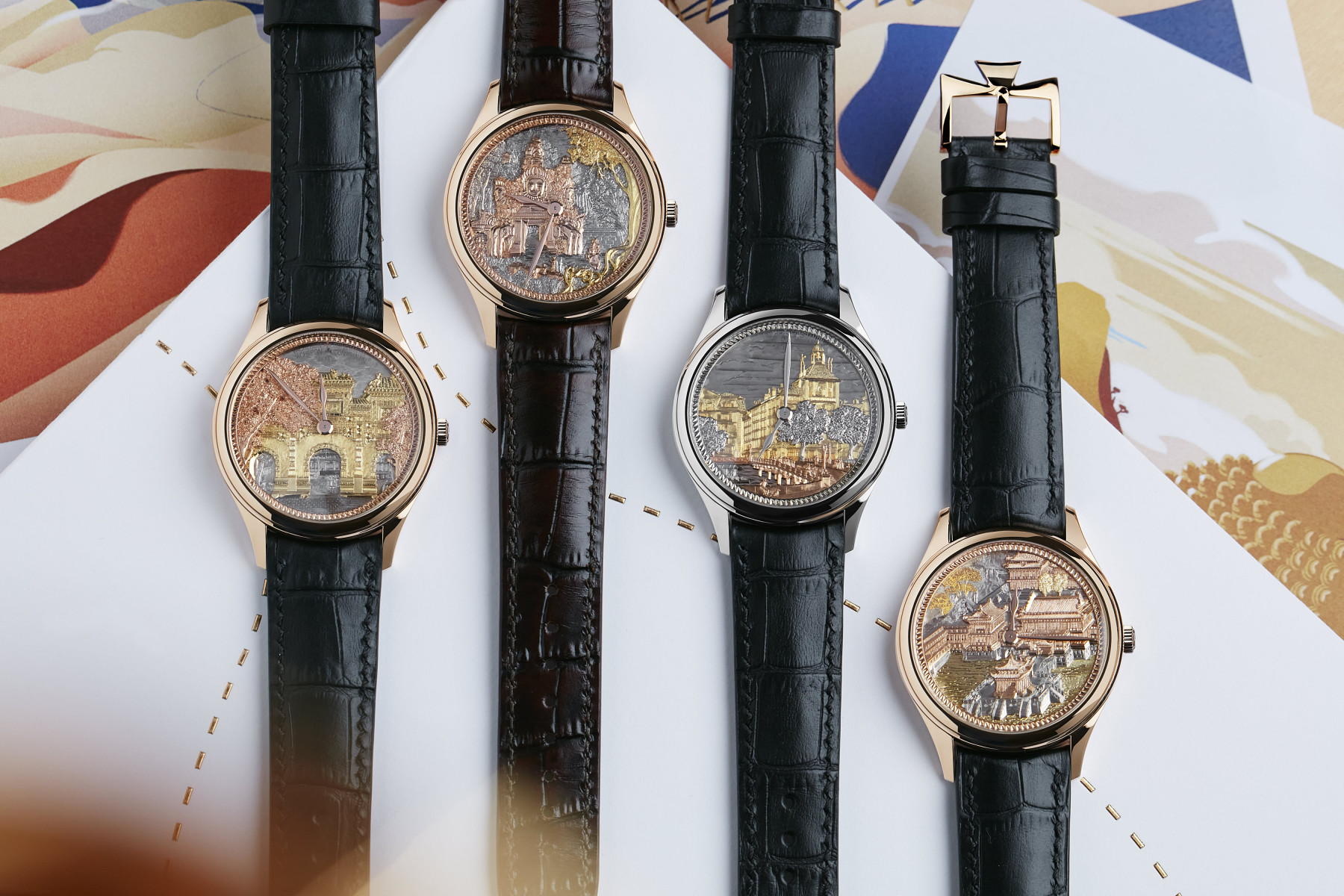Source: Images and content by Vacheron Constantin
http://content.presspage.com/uploads/1999/58a6db9b-8921-42d6-a57e-f2961c1f1edf/500_vac-les-cabinotiers-2000c-all-refs-lfst.jpg?10000
Embargo lifted on 27 November 2023 – 9:00 AM CET
- Les Cabinotiers – Récits de Voyages sets off to discover the world and its wonders in the spirit of openness that has characterised Vacheron Constantin since its origins: among the various destinations departing from Geneva, the historical sites of Asia are key stopovers, notably in China where the Maison has been active since 1845.
- Vacheron Constantin’s artisans pay homage to traditional Asian architecture and to the Maison’s former headquarters by engraving the dials with three golds, a new technique based on 19th century illustrations.
- Emblematic of the Manufacture’s technical mastery, these four watches are powered by in-house Calibre 1120, an ultra-thin self-winding movement.
The single-piece edition timepieces in the new Les Cabinotiers – Récits de Voyages collection reflect Vacheron Constantin’s geographical expansion. As early as the mid-19th century, the Maison felt a need to explore Asian countries and establish commercial contacts, particularly in China, from its historical base in the heart of Geneva. This is reflected in the four Les Cabinotiers – Memorable places watches, whose hand-engraved dials are inspired by period illustrations of famous architectural sites in the Far East and Geneva. They are equipped with in-house Calibre 1120, one of the finest self-winding movements ever produced.
Vacheron Constantin – Far East and Geneva
The first half of the 19th century was synonymous with all-out expansion for Vacheron Constantin. As the Maison found a representative in Brazil, and established itself in Cuba as well as India, all the while delivering its watches to the farthest reaches of the Mediterranean, it was also prospecting the Chinese market. In mid-19th century, new commercial prospects were opened up for Europeans in the context of increasing international exchanges. This was the era of watches for the chinese market that were sold in pairs, designed to withstand humidity and characterised by the richness of their engraved and enamelled decorations. : Vacheron Constantin became the Manufacture that contributed, among others, to establishing the jewellery watch on the Chinese market, in the words of historian Alfred Chapuis, specialized in watchmaking. From the turn of the century onwards, the number of partnerships increased, enabling the Maison to strengthen its presence in Asia.
A sought-after travel destination not least because of the traditional architecture of its temples and palaces, the region was also of interest to many illustrators of the time. It was indeed depictions of Angkor Thom in Cambodia, the Temple of Confucius in Beijing and the former Chinese imperial Old Summer Palace, as depicted by so many 19th century artists, that served as models for the single-piece Les Cabinotiers – Memorable places edition. These timepieces pay tribute to the centuries-old ties with Asia that Vacheron Constantin has woven from Geneva. With this in mind, the Tour de l’Île – Vacheron Constantin’s historical headquarters in Geneva – was also chosen to feature on the dial of a Les Cabinotiers – Memorable places watch inspired by a period engraving. Built in the 13th century as protection against attacks from France, the Château de l’Île burned down several times. Demolished in 1677, all that remained was the tower. Restored two centuries later, it has become one of the town’s key heritage monuments.
Engraving in three gold colours
The dials of Les Cabinotiers – Memorable places watches depict four historical sites using a new technique that combines engraving – and for two of them a touch of damascening. Each dial is composed of several plates cut from yellow, white and pink gold, juxtaposed to form the different coloured elements of the painting, or even superimposed to give depth to this precious assemblage.
Before being assembled, these plates are first engraved using micro-sculpture techniques and line-engraving incisions. The challenge for the master artisan is to work on plates that are no more than 0.4 to 0.8 mm thick, and therefore not to exceed 1 to 2/10ths of a millimetre in engraving them. It takes no less than 200 hours to create a single dial.
Thanks to the precision of the engraver’s deft touch, the reliefs take shape, the depth of field is accentuated, and Nature comes to life. To give an even more realistic touch to the two timepieces representing the site of Angkor and the Imperial Summer Palace in Beijing, he also proceeded to damascene the tree’s foliage. This decorative technique involves embedding a metal wire in an engraved surface, meaning either pink or yellow gold encrusted into a white gold base. Given the dial dimensions, it is a task requiring supremely meticulous care, especially as the gold inlays are only slightly softer than white gold. Each composition is framed by a 40 mm-diameter case in 18K 5N pink gold, surrounded by a slim, engraved circular ring highlighting the extraordinary craftsmanship of these pieces.
A legendary ultra-thin movement, Calibre 1120
Vacheron Constantin has chosen its ultra-thin 1120 self-winding movement to power these watches that discreetly display the hours and minutes by means of leaf-type gold hands. Following on from the legendary manual-winding Calibre 1003 measuring 1.64 mm thick and presented in 1955 to mark Vacheron Constantin’s bicentenary, the Maison began developing Calibre 1120 in 1966, this time with a self-winding mechanism. The objective was the same: to present an ultra-thin movement of great strength and beauty. This goal was reached in 1968 with the launch of a movement measuring just 2.45 mm thick and 28 mm in diameter.
In 2010, with the release of a limited-edition Historiques Ultra-fine 1968, Vacheron Constantin gave a new lease on life to its Calibre 1120. Redesigned with an 18K gold oscillating weight shaped like a Maltese cross, it retained the same size, but with a higher 40-hour power reserve. Bearing the prestigious Hallmark of Geneva, it was taken to the next level in terms of decoration and finishing, with a Côtes de Genève motif, circular-graining, bevelling and straight-grained flanks. Since then, this Calibre 1120 has continued to feature in Vacheron Constantin’s collections, but mainly in new versions where it serves as the base movement for the integration of complication modules, most notably the perpetual calendar.
For this series of watches dedicated to historical architectural achievements and each issued as a single-piece edition bearing the Hallmark of Geneva – certifying both origin and fine craftsmanship – this same Calibre 1120 reappears in its original time-only version. Comprising 144 components and a regulator operating at a rate of 19,800 vibrations per hour (2.75 Hz), it is housed in a case measuring a mere 9.1 mm thick and fitted with an alligator leather strap secured by a pin buckle.
Les Cabinotiers – Memorable places
· Memorable places – La Tour de l’Île
In 1843, Vacheron Constantin moved from Geneva’s “Fabrique” district to the Tour de l’Île, which had previously been occupied by the police force. For a long time, the Tour de l’Île was the only checkpoint along the north-south axis of European communication routes because of the bridge over the Rhône adjoining the building. The Tour de l’Île was home to Vacheron Constantin and its workshops for some 30 years, before the Maison moved to the nearby Quai des Moulins in 1875. The same artisanal techniques are used on the dial of this single-piece edition timepiece, inspired by a drawing by French lithographer Auguste Deroy (1823-1906) and dating from 1881. This strikingly realistic composition is thus presented on a dial composed of seven pink, yellow and white gold elements that are micro-sculpted and line-engraved before being assembled.
· Memorable places – Entrance gate to Angkor Thom
Angkor is one of the most important archaeological sites in South-East Asia. Comprising 200 temples and waterworks spread over some 400 km2 in Cambodia, it contains the remains of the various capitals of the Khmer Empire established between the 9th and 15th centuries. Among these, Angkor Thom, built in the 12th century, was the last and most enduring. The depiction by Louis Delaporte (1842-1925) of the southern gateway to Angkor Thom served as the model for this single-piece edition. Its dial is composed of nine engraved and damascened pink, yellow and white gold plates, assembled and even juxtaposed to create a depth effect. This very meticulous work took some 200 hours to complete.
· Memorable places – Old Summer Palace
Beijing’s historical Summer Palace, originally known as the “Garden of Perfect Clarity”, is a former imperial palace built 15 kilometres from the Forbidden City and home to architectural treasures as well as magnificent art and antique collections. This Palace comprising three gardens covering a 3.5 km2 area was built over a period spanning the 18th and 19th centuries as the main residence of the Qing dynasty. This timepiece is an ode to to the Qing Dynasty Royal Garden culture, its architecture, engraving, sculpture and horticulture: its depiction in an engraving from 1873 served as a model for the dial of this single-piece edition timepiece. Composed of eight engraved and damascened pink, yellow and white gold plates, assembled to form a striking image of the former Summer Palace, this dial represents more than 200 hours of work.
· Memorable places – Entrance gate to Confucius Temple and Imperial College Museum
Built in 1302 under the reign of Témur Khan of the Yuan dynasty, and twice enlarged to occupy 20,000 sqm, Beijing’s Temple of Confucius is the second largest in China. The timepiece is a real tribute to the Confucian culture which is the ground of forming China’s cultural and human activities in the old and contemporary society. The monument is close to the Imperial College, a complex of buildings dating back to the 14th century that served for many years as an administrative centre before being converted into a museum. As shown in a drawing by Emile Thérond (1821-1883), published in an 1864 travel journal, the portico leading to this architectural complex served as an example for the dial of this single-piece edition watch. The dial is composed of six engraved and micro-sculpted pink, yellow and white gold plates, meticulously assembled to create this unique composition in which depth is created by the use of solid colours.
Les Cabinotiers Récits de Voyages series
Vacheron Constantin’s vocation has always been to perfect the art of watchmaking in Geneva while remaining open to the world. The founder’s grandson Jacques-Barthélémi Vacheron (1787-1864) was the first to criss-cross the roads of France and Italy, followed by his partner François Constantin (1788-1854), a tireless traveller who oversaw the commercial development of the Maison. He established commercial relations with Central Europe, South America, Scandinavia and Asia, during a period in time when Vacheron Constantin was also gaining a foothold in the United States and China, as well as in Brazil, Hong Kong and Cuba.
François Constantin’s correspondence stretching over a quarter of a century paints the portrait of a Manufacture that was open to a Europe undergoing major restructuring in the aftermath of the Napoleonic Wars and the Congress of Vienna. This scope and reach continued to expand as the Vacheron Constantin name crossed borders and conquered new markets. Since that time, the very notion of travel has been inherent to the values of the Maison, an integral part of the human adventure characterising its nearly 270-year history. Following in its founders’ footsteps, the Maison offers these Récits de Voyages series as a watchmaking odyssey through the world and its wonders, applying craftsmanship and mechanical art as its means of expression
—————————————————
SUM-UP
To illustrate its Récits de Voyages in Europe and Asia, Vacheron Constantin is presenting four Les Cabinotiers – Memorable places models, each representing a single-piece edition bearing the Hallmark of Geneva and dedicated to the Maison’s spirit of openness to the world. To create the dials of these timepieces featuring the site of Angkor Thom, the former Chinese imperial Old Summer Palace, the the Confucius Temple in Beijing and the Tour de l’Île – the Maison’s 19th century Geneva headquarters century – the Manufacture’s master engravers drew inspiration from illustrations dating from the 19th century, at a time when Vacheron Constantin was making its first contacts with China. The strikingly realistic dials were created using a technique unprecedented at Vacheron Constantin, consisting of micro-sculpting and engraving six to nine extremely thin yellow, pink and white gold plates measuring less than a millimetre thick. These dial components are then assembled and juxtaposed by playing on the shades of gold to form the depiction, or even superimposed to accentuate the reliefs and the depth effects. To make the composition even more realistic, the technique of damascene was also used to create the canopy of the trees featured. These 40 mm-diameter pink gold watches are powered by self-winding Calibre 1120, Vacheron Constantin’s legendary movement, chosen not only for its extreme thinness of 2.45 mm but also for its construction.
————————————–
Interview with Christian Selmoni, Style & Heritage Director
You are presenting new artisanal techniques with the new Récits de Voyages collection, particularly with the Memorable places models. How do you innovate in a field where the techniques are so well known?
The Maison has always ensured that these artistic craft techniques are preserved and continue to fuel its creative universe. While it can now be said that they have become highly sought-after and are as much a part of High Watchmaking as the great mechanical complications, this was certainly not always the case. Not so long ago, certain artistic crafts appeared doomed to disappear. Training centres for the decorative arts were no longer interested in them and the artisans capable of perpetuating these skills were themselves struggling to make a living from their work. For Vacheron Constantin, the transmission of knowledge is essential and constitutes the very foundation of its activity. For this reason, the Manufacture which has always recognised the true value of artistic craftsmanship is committed to preserving these techniques, some of which are in jeopardy. Our collections reflect this commitment. If you cast an inquisitive eye over this world, you’ll find yourself drawn in and amazed by the diversity, creativity and incredible dynamism of these craftspeople. Anyone lucky enough to have attended the Homo Faber events in Venice quickly realised the richness of this world. Here at Vacheron Constantin, we encourage the in-house training of our own artisans, yet we are also always on the lookout for collaborations with the most talented of these experts, who offer tremendous possibilities for innovation. In a nutshell, artistic crafts continue to harbour considerable potential.
While Calibre 1120 is considered a miniature marvel, isn’t that an exaggeration for a movement developed over half a century ago?
We are lucky to be able to count on watchmaking developments that have been milestones across more than two centuries of history and which are perfectly documented thanks to our archives. ‘Lucky’ is perhaps not the apropriate term and I should instead evoke the joy of discovering the technical and mechanical solutions developed at a time when computers were not available to calculate the friction between the components of an escapement or the air penetration coefficient of a balance-spring. Back then, experience spoke the language of the slide rule, without resorting to expedients like silicon. It was a completely different approach to watchmaking. The collectors’ community is of the opinion that the 1120 movement features excellent technical solutions, accompanied by pleasingly, well-proportioned architecture. When Vacheron Constantin unveiled this movement, it was one of the thinnest self-winding calibre of its generation: accurate, reliable and an achievement in itself. When we revisited it in 2010, we made only minor improvements – notably to increase the power reserve with a new oscillating weight thereby providing ample proof that this movement was indeed – almost – perfect right from the outset.
So is China a key market for Vacheron Constantin?
Vacheron Constantin has been active in this market since the mid-19th century. It is therefore a longstanding presence that has grown steadily over the decades. Today, Vacheron Constantin enjoys a presence in the country through around 30 points of sale as well as Maison 1755, a historical building in the Zhangyuan district of Shanghai that offers a unique four-storey immersion into the world of the Maison. We therefore nurtured our links with China very early on and intensified our efforts. Asian customers love Vacheron Constantin watches and are great connoisseurs of artistic crafts. They admire Vacheron Constantin’s elegantly understated style, complete with our characteristic little twist.
————————————–
TECHNICAL DATA
Memorable places – Entrance gate to Angkor Thom
Reference
2000C/000R-103C
Hallmark of Geneva certified timepiece
Caliber
1120
Developed and manufactured by Vacheron Constantin
Mechanical self-winding
28.40 mm diameter, 2.40 mm thick
Movement power reserve: approximately 40 hours
2.75 Hz (19’800 vibrations/hour)
144 components
36 jewels
Indications
Hours and minutes
Case
18K 5N pink gold
40 mm diameter, 9.10 mm thick
Transparent sapphire crystal caseback
Dial
Hand-engraved 18K gold (white, yellow and 5N pink gold) and hand-damascened gold dial representing the entrance gate to Angkor Thom
Strap
Dark brown Mississippiensis alligator leather with alligator leather inner shell, hand-stitched, saddle-finish, large square scales
Clasp
18K 5N pink gold pin buckle
Presentation box & accessory
Les Cabinotiers model
Unique timepiece
« Pièce unique », « Les Cabinotiers » and « AC » hallmark engraved on the back of the timepiece
————————————–
TECHNICAL DATA
Memorable places – Entrance gate to Confucius temple and Imperial college museum
Reference
2000C/000R-105C
Hallmark of Geneva certified timepiece
Caliber
1120
Developed and manufactured by Vacheron Constantin
Mechanical self-winding
28.40 mm diameter, 2.40 mm thick
Movement power reserve: approximately 40 hours
2.75 Hz (19’800 vibrations/hour)
144 components
36 jewels
Indications
Hours and minutes
Case
18K 5N pink gold
40 mm diameter, 9.10 mm thick
Transparent sapphire crystal caseback
Dial
Hand-engraved 18K gold (white, yellow and 5N pink gold) dial representing a gate of the Imperial College and Confucius Temple Museum in Beijing
Strap
Black Mississippiensis alligator leather with alligator leather inner shell, hand-stitched, saddle-finish, large square scales
Clasp
18K 5N pink gold pin buckle
Presentation box & accessory
Les Cabinotiers model
Unique timepiece
« Pièce unique », « Les Cabinotiers » and « AC » hallmark engraved on the back of the timepiece
————————————–
TECHNICAL DATA
Memorable places – Old summer palace
Reference
2000C/000R-104C
Hallmark of Geneva certified timepiece
Caliber
1120
Developed and manufactured by Vacheron Constantin
Mechanical self-winding
28.40 mm diameter, 2.40 mm thick
Movement power reserve: approximately 40 hours
2.75 Hz (19’800 vibrations/hour)
144 components
36 jewels
Indications
Hours and minutes
Case
18K 5N pink gold
40 mm diameter, 9.10 mm thick
Transparent sapphire crystal caseback
Dial
18K hand-engraved gold (white, yellow and 5N pink gold) and hand-damascened gold representing the Old Summer Palace in Beijing
Strap
Black Mississippiensis alligator leather with alligator leather inner shell, hand-stitched, saddle-finish, large square scales
Clasp
18K 5N pink gold pin buckle
Presentation box & accessory Les Cabinotiers model
Unique timepiece
« Pièce unique », « Les Cabinotiers » and « AC » hallmark engraved on the back of the timepiece
————————————–
TECHNICAL DATA
Memorable places – Tour de l’Ile
Reference
2000C/000G-106C
Hallmark of Geneva certified timepiece
Caliber
1120
Developed and manufactured by Vacheron Constantin
Mechanical self-winding
28.40 mm diameter, 2.40 mm thick
Movement power reserve: approximately 40 hours
2.75 Hz (19’800 vibrations/hour)
144 components
36 jewels
Indications
Hours and minutes
Case
18K white gold
40 mm diameter, 9.10 mm thick
Transparent sapphire crystal caseback
Dial
Hand-engraved 18K gold (white, yellow and 5N pink gold) representing the Tour de l’Ile building
Strap
Black Mississippiensis alligator leather with alligator leather inner shell, hand-stitched, saddle-finish, large square scales
Clasp
18K white gold pin buckle
Presentation box & accessory Les Cabinotiers model
Unique timepiece
« Pièce unique », « Les Cabinotiers » and « AC » hallmark engraved on the back of the timepiece








